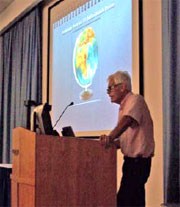DACS General Meeting By Richard Koser
Ken began his presentation with a brief history of photography. The first photograph, requiring an 8-hour exposure, was captured in 1826; the first image showing a person dates back to 1838. Kodak introduced roll film in 1890 and brought out the first Brownie camera intended for amateur use. In 1975, Kodak employee Steve Sasson began development of the digital camera, and Apple in 1994 introduced the first consumer digital camera. Over 3.5 trillion photographs have been taken since the advent of photography and, with the introduction of cell phone cameras, the rate of accumulation became even higher; now over 380 billion per year. Some 300 million images a day are now uploaded to Facebook, which contains 10,000 times as many images as the Library of Congress. All of which brings up the problem of dealing with them. While some casual image takers just leave their images in their digital devices or their prints in shoeboxes, many seek ways to organize and edit them. "You can't fix a picture if you can't find it!" Now digital solutions are available, exemplified by Picasa, the free organizer and editor downloadable from Google (visit Ken's link site - address below). When Picasa is first installed, and each time it is run, it surveys all or some of your computer's images; the survey can be restricted to selected folder(s). It is important to understand that Picasa edits pictures non-destructively - the surveyed images remain intact as originally found, and any subsequent instructions altering an image are remembered by Picasa and remain available for reediting. Images can be tagged with keywords, can be assigned to virtual albums, or can be given star ratings. Picasa can search for images by star ratings; for duplicate images by visual content; by
keyword tags; or by GPS tags, showing their map locations, if your camera has GPS capability. Picasa can convert a virtual album to a disk folder. Picasa can edit pictures by brightness, contrast, color, or toning. It straightens horizons; adds text to images; creates collages in various styles; makes movies from slide shows (time-lapse series for example); creates Web albums for sharing. See Ken's link site (address below) for download and installation instructions. Other free or low-cost editing programs are available: Pixlr Express online editor (pixlr.com/express); iPad Handy Photo app for iOS and Android ($2) (http://advasoft.com/products/handy-photo/). There is also a DSLR Online Camera Simulator that permits visualizing the effects of various camera settings: (camerasim.com/camera- simulator/) Ken's Digital Photography SIG meets the last Wednesday of each month except (typically) December-April. Visit Ken's Web site at <http://grafficx.com/>. Links for tonight's presentation, including Picasa
|
 Click Here |
 |
 |
DacsGear! |
 KEN GRAFF BROUGHT his extensive knowledge to our September General
Meeting presentation, "Where Are My Pictures?" Ken's technical expertise and
aesthetic sensitivity result from his 50-year career in photography including 35 years
as an industrial photographer working at locations around the world. Ken is not unlike
a photographic "Johnny Appleseed," practicing his craft and "planting" photographic
knowledge and wisdom wherever he goes. As he puts it, "Ken now consults with photographers
and enthusiasts in the art of digital imaging. He has been a speaker at photographic and computer groups throughout the country, showing the advantages of digital imaging."
KEN GRAFF BROUGHT his extensive knowledge to our September General
Meeting presentation, "Where Are My Pictures?" Ken's technical expertise and
aesthetic sensitivity result from his 50-year career in photography including 35 years
as an industrial photographer working at locations around the world. Ken is not unlike
a photographic "Johnny Appleseed," practicing his craft and "planting" photographic
knowledge and wisdom wherever he goes. As he puts it, "Ken now consults with photographers
and enthusiasts in the art of digital imaging. He has been a speaker at photographic and computer groups throughout the country, showing the advantages of digital imaging."